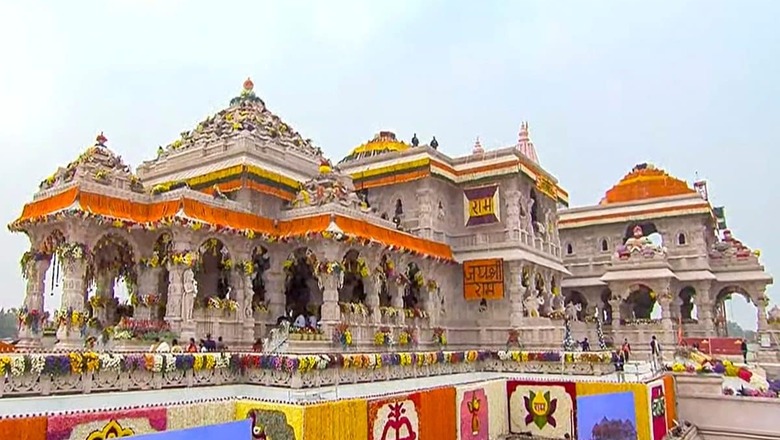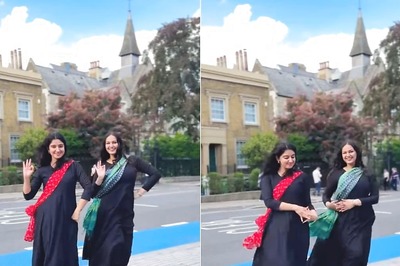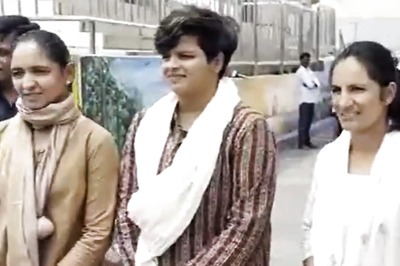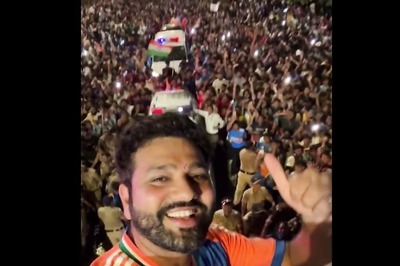
views
I have been an observer of the crisis in Islam, the clash of ideology and its dissenters, particularly described in Ali Allawi’s book, The Crisis in Islamic Civilization, for decades now. The dissenters of radical, political Islam are increasing in numbers; they do not want the dissolution of Islamic supremacists in Islamic as well as non-Islamic areas and people. If Olivier Roy, the French intellectual and author, is to be believed then, radical political Islam failed in the last century due to its lack of answers to the everyday problems of common Muslims. The rise of populist governments all over has provided the space for dissenters of Muslim heritage to openly voice out their heresy (disagreement), controversial opinions, and taboo thoughts without the backlash, the kind that Bangladeshi and Maldivian bloggers and Salman Rushdie have faced all their lives.
The 22 January 2024 Pran Pratishtha event in the Ram Mandir at Ayodhya is attributed to the cultural resurgence of the Indic civilisation and the religious revival of Hinduism. After nearly five centuries of Mughal rule, French, Portuguese, and British colonialism, and the Communist historians’ whitewashing of history, the Ram Mandir was constructed, restoring Ayodhya to its rightful city of reverence and importance. Since childhood, we have been aware of the significance of holy cities, always having the photo frames of Mecca and Medina almost worshipped in Muslim homes. As children, we would get a knuckle-rapping if we knocked them down while dusting or somehow touched them with dirty hands. Such was the admiration for the photo frames of the cities that no one would sit with their feet towards the pictures and our mother’s chappals used to be always ready for a bashing in case we forgot.
Imagine our chagrin when we grew up, the conditioning of the matrix of our society, and unlearning all that we had been taught in the educational institutions of India. If the cities of Mecca, Medina, and Jerusalem had so much meaning and symbolism for the billions of Muslims across the world, why wouldn’t Ayodhya have the same meaning to billions of Hindus across the country and abroad? Two articles in two different portals attempt to answer this question and the travesty of justice that Hindus endured for decades and yet triumphed in triumph. One is from the usual cabal of left-liberal, closet Islamist journalists whom I admire for one exceptional achievement, that of writing the book, Women in Masjid: A Quest for Justice by Ziya us Salam.
His book examines the historical and contemporary status of Muslim women’s access to mosques, particularly in India and other global regions. The central argument asserts that Islam does not prohibit women from participating in mosque prayers; rather, the denial of this right stems from patriarchal and cultural influences. Throughout the narrative, the book illuminates the stories of courageous women who actively advocate for their right to pray in mosques and sheds light on the various challenges they face in this endeavour. In essence, it explores the intersection of religious beliefs, gender equality, and cultural norms, providing a comprehensive examination of the complex dynamics surrounding Muslim women’s access to mosques.
Apart from that, Ziya us Salam, Associate Editor of The Hindu, asserts the Oppression Olympics of Indian Muslims by writing doomsday pieces such as ‘What it is like to be a Muslim in Hindu India?’ In the piece, he says, “To be a Muslim in an increasingly militant Hindu India is to feel alienated and dejected.” This was on the occasion of the Ram Temple consecration, the Pran Pratishtha, or the establishment of the life force, of the Hindu deity on Jan.22 in Ayodhya. To Zia, it is important that the Babri Masjid stood from 1527 to 1992 at the same spot, when it was brought down, brick-by-brick, by karsevaks, or “faith volunteers”, drunk on hardcore Hindutva. Supremacist Indian Muslims, or closet Islamists never question why a masjid stands at the heart of a place that is similar to Mecca, Medina, or Jerusalem to Hindus.
He asserts that more than 2,000 people died, most of them Muslim, in communal riots in various cities in the days that followed. It was never restored, though the Supreme Court in its 2019 judgment called the demolition an “egregious violation of the law”. Now a grand temple dedicated to Lord Ram is being readied atop the ruins of the mosque. Then he starts with the doom and gloom conspiracy theories, “In recent weeks, a new fear, palpable albeit defying definition, can be perceived among Muslims across Delhi and the states of Uttar Pradesh, Uttarakhand, Haryana, and Madhya Pradesh in north and central India. Everywhere there is a saffron surge and in-your-face aggression of Lord Ram’s devotees.”
I wanted to laugh loudly at this — in Muslim-majority pockets of Indian cities, towns, villages, ghettoes, or the state of Kashmir with a Muslim majority population, this in-your-face-Islamism was and has been prevalent for decades ever since 1979 — an important year for the Islamic world. The Iranian Revolution, the Siege of Mecca, and the Afghan-Soviet Jihad’s impact on Kashmir through ISI led to a rivalry for Islamic dominance between Iran and Saudi Arabia. The resulting ‘Black Wave’ brought forth extremist scriptural interpretations and mandatory veiling, as detailed in Kim Ghattas’ book Black Wave: Saudi Arabia, Iran, and the Forty-Year Rivalry That Unraveled Culture, Religion, and Collective Memory in the Middle East (2020), casting its influence over the Indian subcontinent as well.
Ziya’s cabal is responsible for spreading this canard of Muslim small traders and businessmen putting travel plans on hold and cancelling their train bookings on the advice of family elders. This is similar to what we grew up with when the Intifada factory in Kashmir was in control of the narrative, and the ‘Jagmohan canard’ was spread about the ethnic cleansing of Kashmiri Pandits. Ziya’s anecdote about a woman Muslim journalist who went to Ayodhya to cover the temple consecration telling him she felt compelled to wear a Hindu bindi and considered coming back before the ceremony next week, is just one of many that are taken as data for the alleged “Muslim genocide” in India. This canard has been made popular by the likes of Rana Ayyubs, Saba Naqvis, Arfa Khanum Sherwanis, and ‘Fact-checking Zubairs’, boosted by NYT, WaPo, TRT, DW, and Al-Jazeera.
However, not all Indian Muslims support this left-liberal and Islamist-allied narrative, or the disinformation campaign by anti-India forces. Ibn Khaldun Bharat, a pseudonym for an upright citizen of India of Muslim heritage, regularly writes articles for The Print on Indian Muslim issues. That he must use a pseudonym after writing under his name for a few years, signals the toxic trolling and vitriol that critical-thinking, rational Muslims who push for reform in Islam and voice out their opinions, face online and offline. The fact that ZIya us Salam can write biasedly, and unabashedly about the fictional ‘Muslim genocide in India’, while Khaldun Bharati cannot even speak out his opinions and analyses, reveals a lot about the democracy and the alleged ‘fascism’ of India.
Khaldun Bharati, now known as a ‘Renaissance’ writer by non-Muslims, writes the profound words, in his article ‘Ram Mandir construction shows a wounded civilisation healing itself. Muslims will gain from it,’ in The Print. His words are, “What was suppressed was India’s soul, her ancient spirit, and not the modern concept of India. Therefore, freedom would mean the creation of that spirit from which a thousand ideas of India could come to life as they did before being suppressed.”
Bharati is referring to the same event that triggered Ziya us Salam. Bharati discusses the resurgent spirit of Hindutva, highlighting its role in India’s civilisational growth and highlighting that Muslims are integral to this phenomenon. He further asserts that Muslims benefit from the economic, educational, and political advancements in India under Hindutva, asserting that they are superior materially and religiously.
Khaldun has been brave enough to observe the empowerment of Muslims in India’s democracy, contrasting it with Muslim-majority nations. He also mentions the rise of Pasmandas, lower-caste Muslims of Hindu ancestry, as a reflection of India’s revival. He concludes his article by stating that Indians, including Muslims, should support the idea of Akhand Bharat (Undivided India) and India as Vishwa Guru (World Leader), asserting that India will not revert to being a province of the Caucasus.
The Indian Muslim echo chambers will embrace one and dismiss the other. Mind you, the majority of 20 crore Muslims are law-abiding citizens, have accepted the decision of the courts, and are ready for amicable setting aside of differences and moving forward together as a nation with the majority of Hindus. It is the cabal that milks disgruntlement and real instances of anti-Muslim bigotry for their agenda activism, while numerous integrated Muslims have assimilated into the ethos of the new Bharat, that is India. The pseudonym should convey that.
The author is a writer and an educationist from Srinagar. Views expressed in the above piece are personal and solely those of the author. They do not necessarily reflect News18’s views

















Comments
0 comment